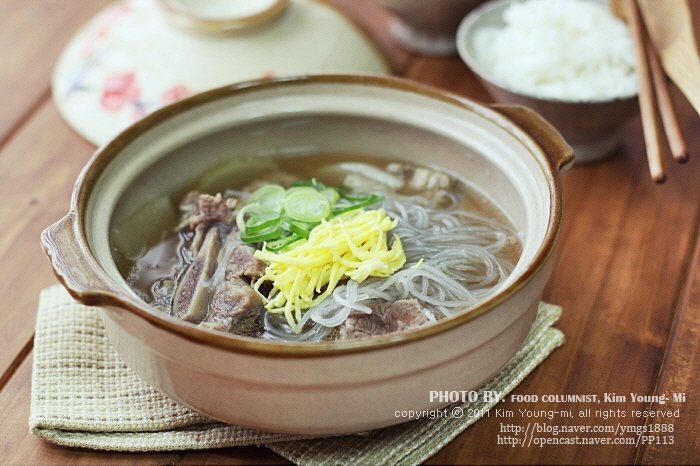Rich and Refreshing Traditional Beef Rib Soup (Galbitang)
Mastering the Art of Making Delicious Beef Rib Soup

Introducing a hearty and invigorating beef rib soup that’s perfect any time. Its clean and deep broth is exceptionally delicious, and the tender rib meat simply melts in your mouth. Enjoy restaurant-quality Galbitang right in your own home!
Main Ingredients- 1kg Beef Ribs (cut for soup)
- 1/2 Onion (cut into large pieces)
- 1/2 piece Daikon Radish (approx. 200g, cut into large pieces)
- 1 stalk Green Onion (white parts, cut into large pieces)
- 10 cloves Garlic (whole)
- 2L Water (enough to generously cover the ribs)
- 1 cup Cheongju (or cooking wine)
- 1/2 piece Daikon Radish (approx. 100g, thinly sliced for garnish)
- 1/2 Green Onion (finely chopped for garnish)
- Egg Yolk and White Strips (for garnish, optional)
- Soaked Glass Noodles (optional)
Rib Marinade and Broth Seasoning- 2 Tbsp Soy Sauce (for soup)
- 1 Tbsp Minced Garlic
- Pinch of Salt (for final seasoning)
- Pinch of Black Pepper
- 2 Tbsp Soy Sauce (for soup)
- 1 Tbsp Minced Garlic
- Pinch of Salt (for final seasoning)
- Pinch of Black Pepper
Cooking Instructions
Step 1
The key to delicious Galbitang starts with removing the blood. Soak the large-cut beef ribs in cold water for about half a day (6-8 hours) to thoroughly bleed them. Changing the water once or twice during this time will yield even better results. Properly removing the blood prevents any gamey odors and ensures a clear broth.

Step 2
After soaking, place the ribs in boiling water and blanch for about 3-5 minutes. This initial blanching step helps to remove residual blood and impurities, preventing the broth from becoming cloudy.

Step 3
Discard the blanching water and rinse the ribs thoroughly under cold running water. Drain them on a sieve to remove excess water. Rinsing the ribs in cold water further cleanses any remaining blood residue on the surface, making them even cleaner.

Step 4
Now, let’s start making the Galbitang broth. Place the prepared ribs in a pot. Add the large-cut 1/2 onion, 1/2 daikon radish, 1 green onion stalk, 10 whole garlic cloves, and 1 cup of Cheongju. Pour in about 2L of water, enough to cover the ribs generously. Bring to a rolling boil over high heat. Once boiling, skim off any scum that rises to the surface, then immediately reduce the heat to low, cover, and simmer for about 1 hour until the ribs are very tender. Slow simmering allows the deep flavor of the ribs to infuse into the broth.

Step 5
After an hour, the ribs should be tender. Carefully remove the cooked ribs from the broth and discard the onion, radish, green onion, and garlic that were simmered with them. Removing the vegetables at this stage helps keep the broth clear and maintains its clean flavor. Set the removed ribs aside to cool slightly.

Step 6
Let’s season the reserved ribs. Place the ribs in a bowl and gently mix them with 2 Tbsp soy sauce, 1 Tbsp minced garlic, and a pinch of black pepper. Let them marinate for a bit to absorb the flavors. (We’ll use salt for final seasoning later.)

Step 7
Prepare the daikon radish for the broth. Thinly slice the remaining 1/2 daikon radish (approx. 100g) into bite-sized pieces. Slicing them not too thin will prevent them from becoming mushy when cooked.

Step 8
Strain the broth used for simmering the ribs (straining again will make it even clearer) into a clean pot. Add the sliced daikon radish and simmer over medium heat for about 15 minutes, until the radish becomes translucent and tender.

Step 9
Once the radish is fully cooked, add the marinated ribs back into the broth. Bring to a simmer and cook for another 5-10 minutes, allowing the flavors to meld. Since the ribs are already tender, they don’t need long cooking.

Step 10
It’s time for the final seasoning. Taste the broth and adjust with salt as needed. You can also add a little more soy sauce if you prefer. Finally, stir in a generous amount of finely chopped green onion and simmer briefly to infuse the fragrant aroma of the onion. Your Galbitang is now complete!

Step 11
Now, it’s time to enjoy your delicious Galbitang! Serve the piping hot soup directly in large bowls, or serve individually in small clay pots (ttukbaegi). If serving in a ttukbaegi, add some soaked glass noodles, simmer briefly, then top with beautifully prepared egg yolk and white strips, and a sprinkle of chopped green onion for a visually appealing and flavorful finish. Enjoy it immediately while it’s piping hot for the best taste experience!




